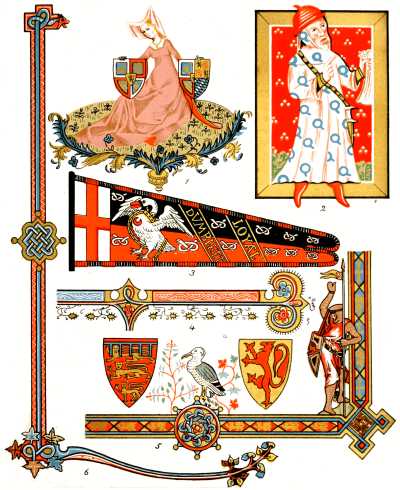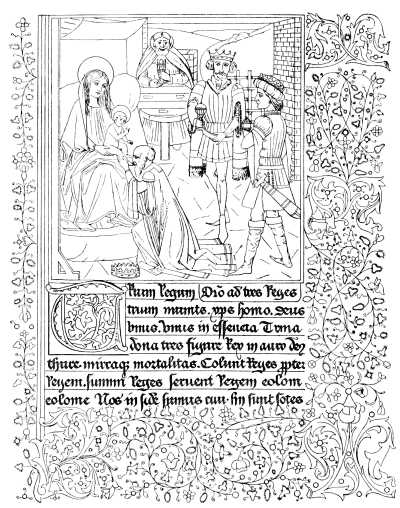

Left: Plate VII. Borders of Thirteenth and Fourteen Centuries, and Heraldic Designs. Right: Border and Text, with Adoration of the Three Kings—Sixteenth Century from Lessons in the Art of Illuminating by W. J. Loftie. Source: Project Gutenberg EBook #40423 produced by Chris Curnow, Matthew Wheaton and the Online Distributed Proofreading Team. [Click on images to enlarge them.]
Description of Plate VII

ictorially considered the illustrations on Plate VII., it must be admitted, are more quaint than beautiful. All the subjects on this page are, with the exception of the thirteenth and fourteenth century borders (6), (4), more or less heraldic in character. It will be best to take them in the order in which they are numbered.
The lady seated (1) holds in either hand the arms of the Duke of Burgundy, slightly varied as to quarterings. The picture is taken from the famous "Bedford Missal" in the British Museum, which is not a missal at all, but a Book of Hours, illuminated in France for the Duke of Bedford, one of the brothers of Henry V. It therefore belongs to the fifteenth century. The lady is sitting on what in heraldry is called "a mount vert," which in turn is supported by the little half architectural scroll-work below; her dress is purple, shaded with grey, in opaque color; the arms are painted in Prussian Blue and Vermilion, the gold being shell.
The gentleman to the right (2) is Sir Nele Loring, a Knight of the Garter. Some time in the fourteenth century a monk of St. Albans, Thomas Walsingham, compiled a list of the benefactors of the abbey, and as far as possible presented his readers with a portrait of each. They are rather rough but eminently picturesque. The book is particularly interesting from the curious particulars it gives us as to the expenses of the illuminator. One Alan Strayler, it tells us, "worked much upon this book," and the editor or compiler ran up a debt with him of the comparatively large sum of three shillings and fourpence, equal to at least £3, 10s. 0d. of our money, for the colors he had used. The book came into the possession of the great Lord Verulam, better known as Lord Chancellor Bacon, and by him it was given to Sir Robert Cotton, who collected the Cottonian MSS. It is known in the British Museum as "Nero D. vii." from its place in the book-case of Sir Robert Cotton which bore the effigy of that Cæsar. Sir Nele, or Nigel, Loring died in 1386, having given the abbey many gifts, and as he was K.G. he is represented in a white robe diapered with "garters."
Our next picture (3) is from a very curious and beautiful, but much injured manuscript, reckoned the number ii. in the collection at Heralds' College. By the kindness of "Somerset Herald" we are allowed to copy it. The book is a list of banners used probably at a tournament in the reign of Henry VIII. Heraldry became more or less the kind of "science" it still is under the last of the Plantagenet kings, and was kept up in great glory by their successors, the first two Tudors. The banner here given is that of Henry Stafford, who was made Earl of Wiltshire in 1509. It shows the swan, the crest of the Staffords, with a crown round its neck and a chain, and the ground, partly black and partly red, the colors of the family, is powdered with "Stafford knots," their badge. Across, in diagonal lines, is the motto "D'Umble et Loyal." These banners, which might well be imitated in modern illumination, are made up of livery colors, with crests and badges, and are usually accompanied by the coat of arms of the person to whom each belonged.
The last of the heraldic features of the page (5) is also the earliest. It represents part of the border of a Psalter made, it is believed, in honour of the intended marriage of Prince Alphonso, the son of Edward I., with a daughter of the King of Arragon. He died at the age of ten years in 1282; but it is possible that the illuminations refer to the intended marriage of his sister, the princess Eleanor, with Alphonso, the young King of Arragon. In any case the manuscript certainly belongs to the middle of the thirteenth century. To the right we see a knight in the chain armour of the period with his shield hung over his arm. Small gold crosses, alternating with "lions rampant" on a blue ground, form part of the border, the other part consisting of "lions passant" on a red ground. Two shields bear, one, the arms of the son of King Edward, "England, differenced with a label, azure," and the other, those of Leon. Crests and mottoes had not been invented, and the artist had little scope for his fancy. But it may not be out of place to call attention to the fact that even at this early period heraldry was made use of for ornament, as in this border, and that it answered the purpose admirably.
On the back of Plate VII. is the outline of an illumination of the Adoration of the Magi, from a French MS. of the 16th century. Borders of this type though very rich seldom occur in books ornamented in England. The branch work is in delicate black lines, with leaves and berries in gold or color. The scrolls are generally in blue, turned up with gold, red, or pink; blue being, however, always the predominant color, so as to insure a certain measure of harmony. The effect, however, depended more on the skill with which the branch work in black was disposed
References
Beckwith, Alice H. R. H. Victorian Bibliomania: The Illuminated Book in Nineteenth-Century Britain. Exhibition catalogue. Providence. Rhode Island: Museum of Art, Rhode Island School of Design, 1987.
Loftie, W. J. . Lessons in the Art of Illuminating: A Series of Examples selected from Works in the British Museum, Lambeth Palace Library, and the South Kensington Museum.. London: London: Blackie & Son, nd. “The Colored Illustrations are Printed by W. G. Blackie & Co., Glasgow, from Drawings by J. A. Burt.” Project Gutenberg EBook #40423 produced by Chris Curnow, Matthew Wheaton and the Online Distributed Proofreading Team. Web. 11 January 2014.
Last modified 11 January 2014